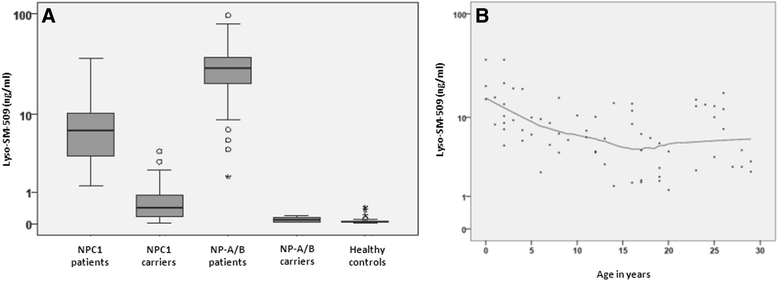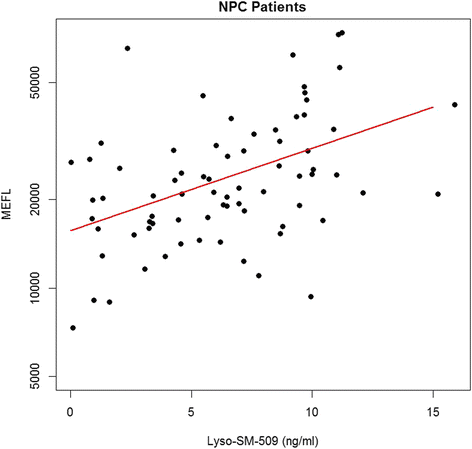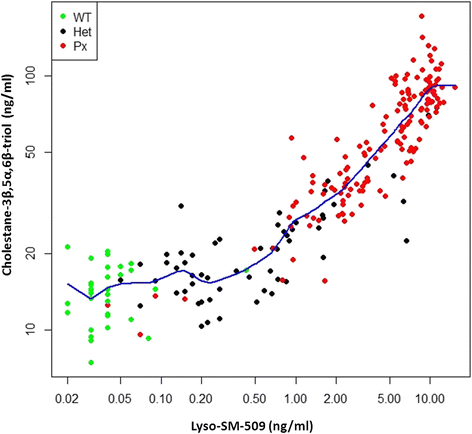A novel, highly sensitive and specific biomarker for Niemann-Pick type C1 disease
- PMID: 26082315
- PMCID: PMC4479076
- DOI: 10.1186/s13023-015-0274-1
A novel, highly sensitive and specific biomarker for Niemann-Pick type C1 disease
Abstract
Background: Lysosomal storage disorders (LSDs), are a heterogeneous group of rare disorders caused by defects in genes encoding for proteins involved in the lysosomal degradation of macromolecules. They occur at a frequency of about 1 in 5,000 live births, though recent neonatal screening suggests a higher incidence. New treatment options for LSDs demand a rapid, early diagnosis of LSDs if maximal clinical benefit is to be achieved.
Methods: Here, we describe a novel, highly specific and sensitive biomarker for Niemann-Pick Type C disease type 1 (NPC1), lyso-sphingomyelin-509. We cross-validate this biomarker with cholestane-3β,5α,6β-triol and relative lysosomal volume. The primary cohort for establishment of the biomarker contained 135 NPC1 patients, 66 NPC1 carriers, 241 patients with other LSDs and 46 healthy controls.
Results: With a sensitivity of 100.0% and specificity of 91.0% a cut-off of 1.4 ng/ml was established. Comparison with cholestane-3β,5α,6β-triol and relative acidic compartment volume measurements were carried out with a subset of 125 subjects. Both cholestane-3β,5α,6β-triol and lyso-Sphingomyelin-509 were sufficient in establishing the diagnosis of NPC1 and correlated with disease severity.
Conclusion: In summary, we have established a new biomarker for the diagnosis of NPC1, and further studies will be conducted to assess correlation to disease progress and monitoring treatment.
Figures






Similar articles
-
A sensitive and specific LC-MS/MS method for rapid diagnosis of Niemann-Pick C1 disease from human plasma.J Lipid Res. 2011 Jul;52(7):1435-45. doi: 10.1194/jlr.D015735. Epub 2011 Apr 24. J Lipid Res. 2011. PMID: 21518695 Free PMC article.
-
Rapid Diagnosis of 83 Patients with Niemann Pick Type C Disease and Related Cholesterol Transport Disorders by Cholestantriol Screening.EBioMedicine. 2015 Dec 22;4:170-5. doi: 10.1016/j.ebiom.2015.12.018. eCollection 2016 Feb. EBioMedicine. 2015. PMID: 26981555 Free PMC article.
-
Cholestane-3β, 5α, 6β-triol: Further insights into the performance of this oxysterol in diagnosis of Niemann-Pick disease type C.Mol Genet Metab. 2020 May;130(1):77-86. doi: 10.1016/j.ymgme.2020.02.008. Epub 2020 Mar 5. Mol Genet Metab. 2020. PMID: 32178982
-
Diagnostic tests for Niemann-Pick disease type C (NP-C): A critical review.Mol Genet Metab. 2016 Aug;118(4):244-54. doi: 10.1016/j.ymgme.2016.06.004. Epub 2016 Jun 7. Mol Genet Metab. 2016. PMID: 27339554 Review.
-
Immune dysfunction in Niemann-Pick disease type C.J Neurochem. 2016 Jan;136 Suppl 1(Suppl Suppl 1):74-80. doi: 10.1111/jnc.13138. Epub 2015 Jun 4. J Neurochem. 2016. PMID: 25946402 Free PMC article. Review.
Cited by
-
Chronic visceral acid sphingomyelinase deficiency (Niemann-Pick disease type B) in 16 Polish patients: long-term follow-up.Orphanet J Rare Dis. 2019 Feb 22;14(1):55. doi: 10.1186/s13023-019-1029-1. Orphanet J Rare Dis. 2019. PMID: 30795770 Free PMC article.
-
Experience of the NPC Brazil Network with a Comprehensive Program for the Screening and Diagnosis of Niemann-Pick Disease Type C.Int J Neonatal Screen. 2022 Jun 28;8(3):39. doi: 10.3390/ijns8030039. Int J Neonatal Screen. 2022. PMID: 35892469 Free PMC article.
-
Consensus clinical management guidelines for acid sphingomyelinase deficiency (Niemann-Pick disease types A, B and A/B).Orphanet J Rare Dis. 2023 Apr 17;18(1):85. doi: 10.1186/s13023-023-02686-6. Orphanet J Rare Dis. 2023. PMID: 37069638 Free PMC article.
-
Identification of a Reliable Biomarker Profile for the Diagnosis of Gaucher Disease Type 1 Patients Using a Mass Spectrometry-Based Metabolomic Approach.Int J Mol Sci. 2020 Oct 23;21(21):7869. doi: 10.3390/ijms21217869. Int J Mol Sci. 2020. PMID: 33114153 Free PMC article.
-
Determination of the Pathological Features of NPC1 Variants in a Cellular Complementation Test.Int J Mol Sci. 2019 Oct 19;20(20):5185. doi: 10.3390/ijms20205185. Int J Mol Sci. 2019. PMID: 31635081 Free PMC article.
References
-
- Fuller M, Meikle PJ, Hopwood JJ. Epidemiology of lysosomal storage diseases: an overview. Oxford: Oxford PharmaGenesis; 2006. p. 2006. Chapter 2. - PubMed
Publication types
MeSH terms
Substances
Grants and funding
LinkOut - more resources
Full Text Sources
Other Literature Sources
Medical

